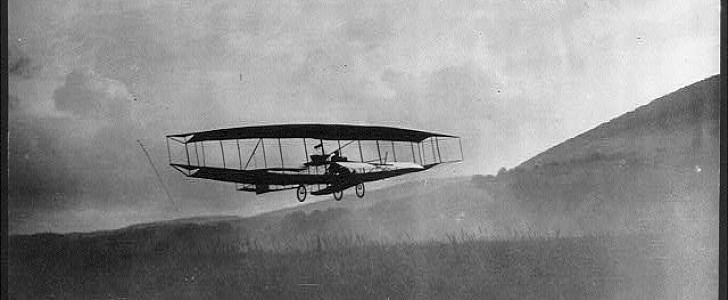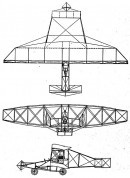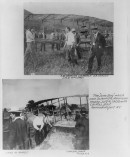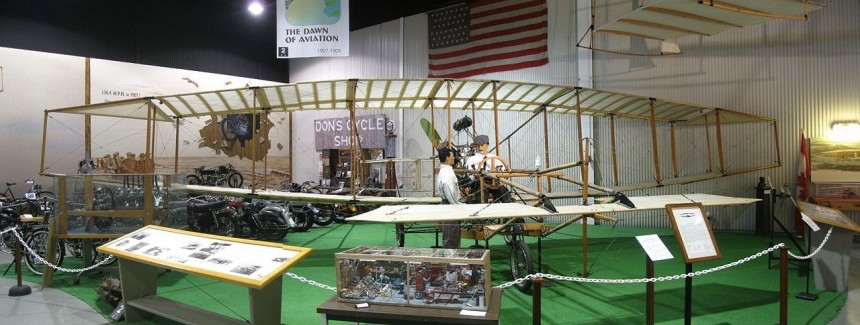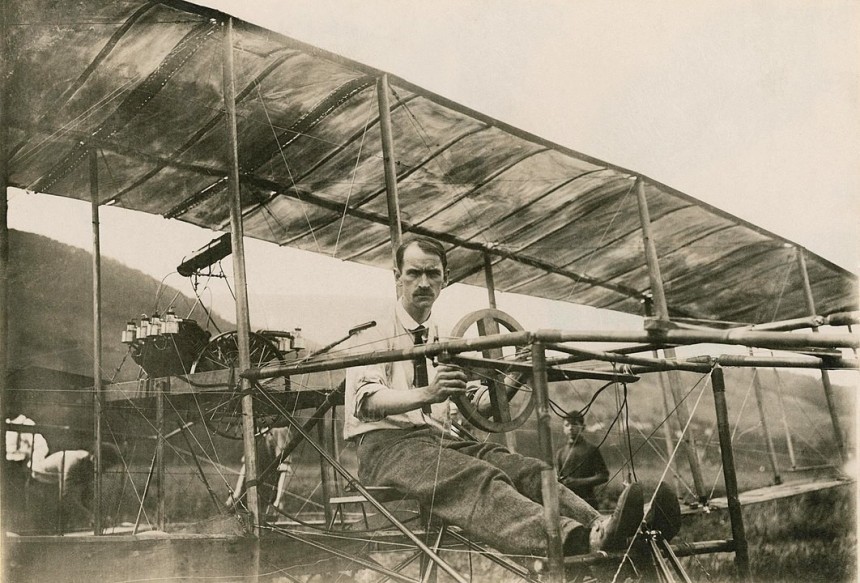As the Hush Kit YouTube Channel put so eloquently in their video The 10 Worst American Aircraft, "the Wright Brothers were as litigious as they were diligent and busily sued anyone who built a successful aircraft." In short, the Wright Brothers tried to sue the pants off anyone who tried to build a machine with even a passing similarity to a Wright Flyer.
Glenn Hammond Curtiss was one of the parties made the most livid by Wilbur and Orville's legal tomfoolery. The resulting story is one of American Aviation's first true pieces of folklore. If you've seen any of our recent items on the life and inventions of Glenn H. Curtiss. In that case, you'll know he made a habit of showing up to his contemporaries by building better machines than they did. Be it airplanes or motorcycles.
All while making himself fabulously wealthy. That's why his inevitable modern-day analog as the archetype eccentric billionaire aviator is usually Elon Musk. He purchased three entire towns in Florida. Miami Springs, Hialeah, and Opa-Locka, for crying out loud. If that's not the "Buying Twitter" moment of the early 20th century, we don't know what is.
In the same way that Elon routinely makes himself a thorn in the side of NASA while simultaneously renting out their most famous launchpad, Curtiss and the AEA organization he worked for became one of the very first legitimate competitors for the Wright Brothers. The story behind the beef is one of the first great rivalries in American aviation. The vitriol between the two parties makes Lockheed Martin and Northrop-Grumman's current relationship look like a tea party.
In an effort to prove people other than two bicycle makers from Ohio could build airplanes, Curtiss modified the existing airframe of Samuel P. Langley's failed Aerodrome to the point it could maintain sustained flight for all of the five seconds before Curtiss called it a day in 1914. More than likely for his own safety. In the end, this made the Wright Brother's patients for the rights to all American airplanes null and void.
But why did Glenn Curtiss go to such great lengths to spite the Wrights? It likely had a lot to do with the Wright's response to Curtiss up-staging them, helping the Aerial Experiment Association top-trump them back in 1908. It's a brilliant story of ingenuity, determination, and a liberal dose of spite from both parties.
With the funding from the AEA, headed by Dr. Alexander Graham Bell, Curtiss's AEA June Bug proved that airplanes could be easy to fly. Unlike the Wright Flyer's first flight, which only proved that airplanes were impractical with their less than impressive performance. With a tricycle landing gear arrangement that was innovative for its time, the AEA's June Bug, as it was soon christened, spat in the face of the Wright Brother's iconically misguided notion that taking off from a fixed set of rails was the future of manned flight.
In an era where aristocrats across North America and Europe issued aeronautical challenges worth million in modern money, the June Bug set out to make the first verified flight over one kilometer (3,280 ft) for a grand cash prize of $25,000 in cash, or just over $804,812 in 2022 money. After its first flight in June 1908, legend has it, Curtiss penned a letter to the brothers Wilbur and Orville, offering them the opportunity at the taking Scientific American Cup's prize before he did. An offer both brothers subsequently declined. And so, June Bug took to the skies on Independence Day 1908.
With a 40 horsepower air-cooled V8 Curtiss B-8 piston engine mounted behind the pilot, novel designs for horizontal and vertical control surfaces like ailerons, elevators, and rudders instead proved infinitely more controllable than wing warping. Even so, the Wright brothers were quick to issue s cease and desist notice to the AEA as soon as their got word of June Bug's first flight.
In any case, the June Bug flew 1.6 kilometers, or one mile exactly, on its second attempt at the Scientific American Cup prize. Much to the delight of those who gathered in a field next to the Pleasant Valley Wine Company, who happily accepted free samples, which soon turned into bottles of the good stuff being sold by the crate during the record attempt. Once the minute and the 40-second long flight was over, the winery opened up its cellars with free champagne for all, as if it were a sports team that had just won the world championship.
Fittingly enough, Curtiss was more or less the MVP of the pioneer age of aviation. It's a fact that, at least according to archived contemporary accounts from the time, drove Wilbur and Orville Wright totally bananas. The June Bug was later modified with floating pontoons and took off from the waters of Keuka Lake in Central New York before crashing in January 1909. Today, an airworthy replica of June Bug is on display at the Glenn H. Curtiss Museum in Hammondsport, New York. A place autoevolution was fortunate enough to visit this year.
Check out that piece if you want to learn more. Check back real soon for more from V8 Month.
All while making himself fabulously wealthy. That's why his inevitable modern-day analog as the archetype eccentric billionaire aviator is usually Elon Musk. He purchased three entire towns in Florida. Miami Springs, Hialeah, and Opa-Locka, for crying out loud. If that's not the "Buying Twitter" moment of the early 20th century, we don't know what is.
In the same way that Elon routinely makes himself a thorn in the side of NASA while simultaneously renting out their most famous launchpad, Curtiss and the AEA organization he worked for became one of the very first legitimate competitors for the Wright Brothers. The story behind the beef is one of the first great rivalries in American aviation. The vitriol between the two parties makes Lockheed Martin and Northrop-Grumman's current relationship look like a tea party.
In an effort to prove people other than two bicycle makers from Ohio could build airplanes, Curtiss modified the existing airframe of Samuel P. Langley's failed Aerodrome to the point it could maintain sustained flight for all of the five seconds before Curtiss called it a day in 1914. More than likely for his own safety. In the end, this made the Wright Brother's patients for the rights to all American airplanes null and void.
But why did Glenn Curtiss go to such great lengths to spite the Wrights? It likely had a lot to do with the Wright's response to Curtiss up-staging them, helping the Aerial Experiment Association top-trump them back in 1908. It's a brilliant story of ingenuity, determination, and a liberal dose of spite from both parties.
With the funding from the AEA, headed by Dr. Alexander Graham Bell, Curtiss's AEA June Bug proved that airplanes could be easy to fly. Unlike the Wright Flyer's first flight, which only proved that airplanes were impractical with their less than impressive performance. With a tricycle landing gear arrangement that was innovative for its time, the AEA's June Bug, as it was soon christened, spat in the face of the Wright Brother's iconically misguided notion that taking off from a fixed set of rails was the future of manned flight.
In an era where aristocrats across North America and Europe issued aeronautical challenges worth million in modern money, the June Bug set out to make the first verified flight over one kilometer (3,280 ft) for a grand cash prize of $25,000 in cash, or just over $804,812 in 2022 money. After its first flight in June 1908, legend has it, Curtiss penned a letter to the brothers Wilbur and Orville, offering them the opportunity at the taking Scientific American Cup's prize before he did. An offer both brothers subsequently declined. And so, June Bug took to the skies on Independence Day 1908.
With a 40 horsepower air-cooled V8 Curtiss B-8 piston engine mounted behind the pilot, novel designs for horizontal and vertical control surfaces like ailerons, elevators, and rudders instead proved infinitely more controllable than wing warping. Even so, the Wright brothers were quick to issue s cease and desist notice to the AEA as soon as their got word of June Bug's first flight.
Fittingly enough, Curtiss was more or less the MVP of the pioneer age of aviation. It's a fact that, at least according to archived contemporary accounts from the time, drove Wilbur and Orville Wright totally bananas. The June Bug was later modified with floating pontoons and took off from the waters of Keuka Lake in Central New York before crashing in January 1909. Today, an airworthy replica of June Bug is on display at the Glenn H. Curtiss Museum in Hammondsport, New York. A place autoevolution was fortunate enough to visit this year.
Check out that piece if you want to learn more. Check back real soon for more from V8 Month.
